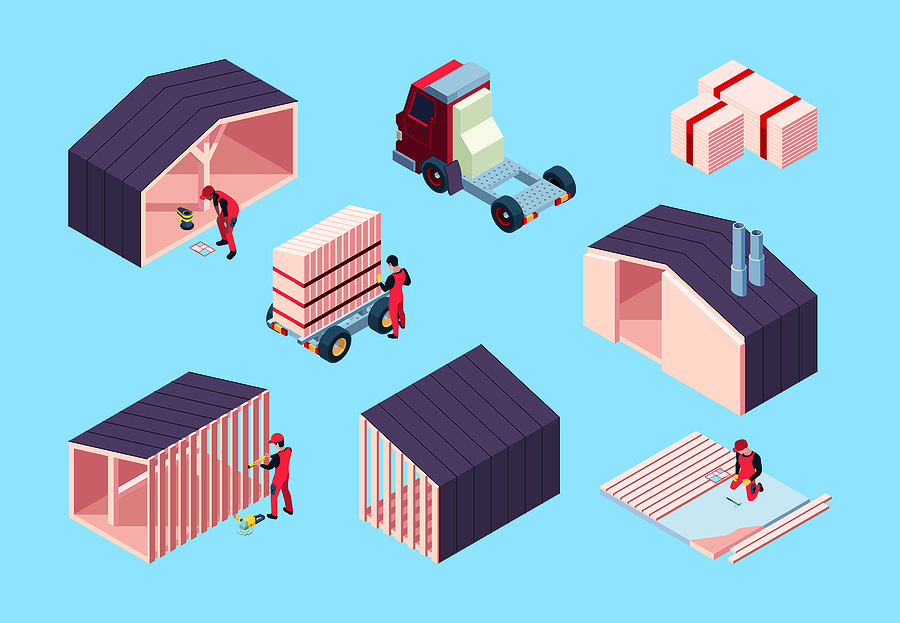
Advantages and Disadvantages of Modular Buildings
Modular buildings, also known as prefabricated or prefab buildings, have gained popularity in recent years due to their innovative approach to construction. Rather than being built on-site, these structures are manufactured off-site in sections or “modules” that are later assembled on location. This method of construction offers numerous advantages, but it also comes with certain disadvantages that are worth considering.
Advantages of Modular Buildings
Speed of Construction
One of the primary advantages of modular buildings is the speed of construction. Because modules are built in a factory, construction can proceed regardless of weather conditions. Once the modules are complete, they’re transported to the site and assembled, which takes less time than traditional construction. In many cases, this can reduce construction timelines by 30 to 50 percent.

Cost-Effective
Modular buildings can be more cost-effective than traditionally built structures. Controlled factory conditions mean less wasted materials and better utilization of resources. Additionally, the decreased construction time leads to savings in labor costs and earlier utilization of the building for its intended purpose, which contributes to a quicker return on investment.
Environmentally Friendly
Prefabricated construction processes can be more environmentally friendly than traditional methods. It minimizes waste through precise construction and reuse of leftover materials. Moreover, the controlled environment of a factory reduces the risk of environmental damage and pollution that often occur at traditional construction sites.
Quality Control
Modular buildings are built in factories under controlled conditions, following defined standards and stringent quality controls. This results in a consistently high quality of construction that may exceed what can be achieved in the often unpredictable conditions of a traditional construction site.
Disadvantages of Modular Buildings
Design Limitations
Modular buildings have certain inherent design limitations. The need to transport modules to the site places restrictions on their size and shape. Although there are a vast array of design options available, particularly complex or unconventional architectural designs might not be feasible with modular construction.

Perceptions and Stigma
Despite their many benefits, modular buildings sometimes face negative perceptions. Some people still associate them with temporary structures or low-quality construction, even though modern modular buildings can be permanent and high-quality. This stigma can impact everything from the resale value of a building to the willingness of communities to accept modular construction projects.
Site Preparation
While the modules are being manufactured, the building site must be prepared simultaneously. This can lead to additional costs and complications if the site preparation and module construction are not correctly synchronized.
Transportation and Logistics
Transporting large modules from the factory to the construction site can be a significant challenge. It requires careful planning and can add to the overall cost of the project. Furthermore, the process might be restricted by factors such as road conditions, bridge capacities, and traffic regulations.

Modular buildings offer a range of advantages, including speed of construction, cost-effectiveness, environmental benefits, and quality control. However, they also come with a set of challenges, such as design limitations, negative perceptions, site preparation complications, and transportation and logistical concerns. Like any construction method, the suitability of modular construction depends on the specific requirements and constraints of the project. Understanding both the pros and cons is crucial to making an informed decision.
Is Modular Construction Better?
Whether modular construction is “better” largely depends on the specific needs, circumstances, and objectives of a construction project. Here are a few factors to consider when deciding if modular construction is the best fit for your project:
- Speed of Construction: If you are on a tight timeline and need a building ready as quickly as possible, modular construction is likely a good choice. The process is usually faster than traditional construction because site work and building construction can occur simultaneously, and work is not delayed by weather conditions or other onsite challenges.
- Budget: Modular buildings can be more cost-effective due to savings in labor costs, reduced material waste, and an accelerated timeline that allows for quicker occupancy. However, it’s worth noting that transportation and site preparation costs could impact the overall budget.
- Quality and Consistency: If consistent quality is a top priority, modular buildings are built in a controlled environment that reduces the chance of defects caused by weather or onsite variables.
- Sustainability Goals: If environmental sustainability is a significant concern, modular construction can be a more eco-friendly choice because it generally produces less waste and requires less material than traditional construction.
- Design Requirements: If the project requires a highly unique or architecturally complex design, traditional construction might be a better choice, as it allows for more design flexibility. While modular design options have greatly expanded, there are still some limitations due to the need for transport and assembly.
- Site Constraints: If the project site is located in a dense urban area or a remote location, it might be easier to build the modules off-site and then transport them.
However, it’s crucial to remember that every construction project is unique, and what works well for one project may not be suitable for another. Therefore, the decision should be based on a thorough analysis of the project requirements, budget, timeline, and long-term goals. In some cases, a hybrid approach may even be the best solution, combining elements of both modular and traditional construction to achieve the project’s goals.
Types of Modular Construction
Modular construction is a process where a building or a part of it is built off-site under controlled conditions, which are then transported and assembled at the construction site. There are different types of modular construction based on the kind of module, use, and construction method. Let’s explore them:
1. Volumetric Modular Construction: In volumetric modular construction, entire rooms or sections of a building, fully completed with internal and external finishes, services, and fittings, are constructed off-site. These three-dimensional modules are then transported to the site and assembled to form the structure. This is the most comprehensive form of modular construction, as modules are significantly complete before they arrive at the site.
2. Non-Volumetric (Panelized) Modular Construction: Non-volumetric or panelized modular construction involves the off-site production of panel units. These could be wall panels, floor panels, or roof panels. Once these flat panel modules are transported to the site, they are assembled to form the structure. These are less complete than volumetric modules and may require additional site work for completion.
3. Hybrid Modular Construction: As the name suggests, hybrid modular construction is a blend of both volumetric and non-volumetric modular construction. Certain components of the building are volumetrically constructed while others are panelized. This allows the benefits of both types of construction to be leveraged depending on the specific needs of the project.
4. Site-Based Modular Construction: In site-based modular construction, components are built off-site, then brought to the construction site for assembly. However, unlike the other forms of modular construction, the completed modules are assembled and finalized at the site rather than in the factory.
5. Portable or Relocatable Buildings: This category of modular buildings is designed to be reused or repurposed multiple times and transported to different locations as needed. They are not permanently installed but are designed to be durable and withstand multiple moves. Examples of this type include classrooms, construction site offices, and medical clinics.
6. Permanent Modular Construction (PMC): PMC involves modules constructed off-site in a controlled environment and then transported and installed at the final building site for permanent use. PMC can be utilized for both residential and commercial structures, including homes, offices, schools, and healthcare facilities.
Each of these types of modular construction has its unique advantages and is suitable for different kinds of projects. Factors such as project timeline, budget, location, and intended use of the building all play a role in determining the most appropriate type of modular construction to use.
